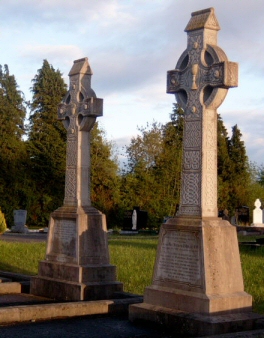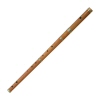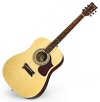Celtic Cross
Myths, Legends, Heroes and Saints
 The national flag is a tricolour of green, white
and orange. The three colours are of equal size, vertically disposed, and
the green is displayed next to the staff. The flag was first introduced during the revolutionary year of 1848 as an emblem of the Young Ireland
movement, and it was often seen displayed at meetings alongside the French
tricolour. The green represents the
older Gaelic and Anglo-Norman element in the population, while the orange represents the Protestant
planters and their descendants, supporters of William of Orange. The meaning of the white was
well expressed 'The white in the centre signifies a lasting truce between the '
The national flag is a tricolour of green, white
and orange. The three colours are of equal size, vertically disposed, and
the green is displayed next to the staff. The flag was first introduced during the revolutionary year of 1848 as an emblem of the Young Ireland
movement, and it was often seen displayed at meetings alongside the French
tricolour. The green represents the
older Gaelic and Anglo-Norman element in the population, while the orange represents the Protestant
planters and their descendants, supporters of William of Orange. The meaning of the white was
well expressed 'The white in the centre signifies a lasting truce between the '

Prior to the War of Independence (1919-21) the green flag with gold harp was the main symbol of nationalism.
|
The Soldier's Song
Amhrán na bhFiann (Gaelic) Lyrics: Peadar Kearny, 1907
Music: Patrick Heeney, c.1911
We'll sing a song, a soldier's song,
With cheering rousing chorus,
As round our blazing fires we throng,
The starry heavens o'er us;
Impatient for the coming fight,
And as we wait the morning's light,
Here in the silence of the night,
We'll chant a soldier's song.
Chorus:
Soldiers are we whose lives are pledged to
Some have come from a land beyond the wave.
Sworn to be free,
No more our ancient sire land
Shall shelter the despot or the slave.
Tonight we man the gap of danger
In
'Mid cannons' roar and rifles peal,
We'll chant a soldier's song.
|
In valley green, on towering crag,
Our fathers fought before us,
And conquered 'neath the same old flag
That's proudly floating o'er us.
We're children of a fighting race,
That never yet has known disgrace,
And as we march, the foe to face,
We'll chant a soldier's song.
Chorus
Sons of the Gael! Men of the Pale!
The long watched day is breaking;
The serried ranks of Inisfail
Shall set the Tyrant quaking.
Our camp fires now are burning low;
See in the east a silv'ry glow,
Out yonder waits the Saxon foe,
So chant a soldier's song.
Chorus
|

The harp has been recognised as a symbol of Ireland since the 13th century, and first appeared on Anglo-Irish coinage of 1536 during the reign of Henry VIII. It is sometimes referred to as the harp of Brian Boru, High King of Ireland from the 11th century. It appears in the third quarter of the Royal Coat of Arms of the United Kingdom. The harp was selected as the state emblem on the establishment of the Irish Free State (1922). It continued to be a state emblem after the Constitution of Ireland was adopted (1937).
St. Patrick’s Day (17th
March) is an official Bank Holiday in
Saint Patrick is the Patron Saint of
Ireland and the one credited with bringing Christianity to
History and legend are
intertwined when it comes to St. Patrick. It is known that he was born in
While not the
first to bring Christianity to
According to tradition St.
Patrick died on 17th March in A.D. 493 and was buried in the same grave as St.
Bridget and St. Columba, at Downpatrick,
 In written English, the first
reference to the Shamrock dates from 1571, and in written Irish, as seamrog,
from 1707. As a badge to be worn on
Saint Patrick’s day, it is referred to for the first time as late as
1681. The Shamrock was used as an emblem by the Irish Volunteers in the era of
Grattan's Parliament in the 1770's, before The Act of Union. So rebellious did
the wearing of the Shamrock eventually appear, that in Queen
In written English, the first
reference to the Shamrock dates from 1571, and in written Irish, as seamrog,
from 1707. As a badge to be worn on
Saint Patrick’s day, it is referred to for the first time as late as
1681. The Shamrock was used as an emblem by the Irish Volunteers in the era of
Grattan's Parliament in the 1770's, before The Act of Union. So rebellious did
the wearing of the Shamrock eventually appear, that in Queen

A Celtic cross combines the cross with a ring surrounding the intersection. It is the characteristic symbol of Celtic Christianity, though it may have older, pre-Christian origins. In Ireland many free-standing upright crosses (high crosses) were erected, beginning at least as early as the 7th Century. Some of these 'Celtic' crosses bear inscriptions in runes. There are surviving free-standing crosses in Cornwall and Wales, in the island of Iona and in the Hebrides also. There are many variations of interpretations and legends about the original meaning of the Celtic cross. The Irish Catholic priest will have no hesitation telling you that the circle of the Celtic Cross is a symbol of eternity that emphasizes the endlessness of God’s love as shown through Christ’s sacrifice on the cross. That is unless he says the circle is a halo. At the pub when the subject comes up you might just as likely hear the explanation that the great stone Celtic Crosses were carved from the standing stones of the Druids and were originally phallic symbols.
Most of the oldest songs, tunes, and methods are rural in origin. Music and lyrics are passed aurally/orally, and were rarely written down until 1800s. Due to the importance placed on the melody in Irish music, harmony should be kept simple, and instruments are played in strict unison, always following the leading player. Irish traditional music was largely meant for dancing at celebrations for weddings, saint's days or other observances. Basic instruments are the following (click & listen):
Myths, Legends, Heroes and Saints
 Irish
history is rich with myths and legends. The adventures of the famous
seer-warrior Fionn Mac Cumhaill are still known to many Irish people. These
include how he gained his wisdom as a boy by tasting the 'salmon of knowledge',
how he triumphed over miscellaneous giants and magicians, and how he had the
truths of life explained to him in a strange allegorical house.
Irish
history is rich with myths and legends. The adventures of the famous
seer-warrior Fionn Mac Cumhaill are still known to many Irish people. These
include how he gained his wisdom as a boy by tasting the 'salmon of knowledge',
how he triumphed over miscellaneous giants and magicians, and how he had the
truths of life explained to him in a strange allegorical house.
The champion Lugh, originally a god of the Continental Celts, is also remembered - especially how he slew his tyrant grandfather who had a horrific eye which destroyed all on which it gazed.
The adventures of
the super warrior Cú Chulainn (left) are spoken of and tales are also told of more
true to life characters, such as the quasihistorical High-King Cormac Mac Airt
and the historical though much romanticised Conall Gulban, son of the great
king Niall and contemporary of
St Patrick.
The saints,
historical personages from the early centuries of Irish Christianity, are
portrayed in legends as miracle workers who used their sacred power to banish
monsters, cure illnesses, and provide food for the people in time of need.
Holy wells, dedicated to individual saints, are still visited on their feast
days in many areas, and people pray at these wells for relief from different
kinds of physical and mental distress. The most celebrated saints in
![]()
T

The Leprechaun is an
Irish fairy. He
looks like a small, old man (about 2 feet tall), often dressed like a
shoemaker, with a cocked hat and a leather apron. According to legend,
leprechauns are aloof and unfriendly, live alone, and pass the time making
shoes. They also possess a hidden pot of gold. Treasure hunters can often
track down a leprechaun by the sound of his shoemaker's hammer. If caught, he
can be forced (with the threat of bodily violence) to reveal the whereabouts of
his treasure, but the captor must keep their eyes on him every second. If the
captor's eyes leave the leprechaun (and he often tricks them into looking
away), he vanishes and all hopes of finding the treasure are lost.
learn more:
Reference Information about Ireland
Irish Literature and Mythology
sources:
Wikipedia: Celtic cross
1.
Myths, Legends, Heroes and Saints
©
Ireland Now
1997-2005
![]()







